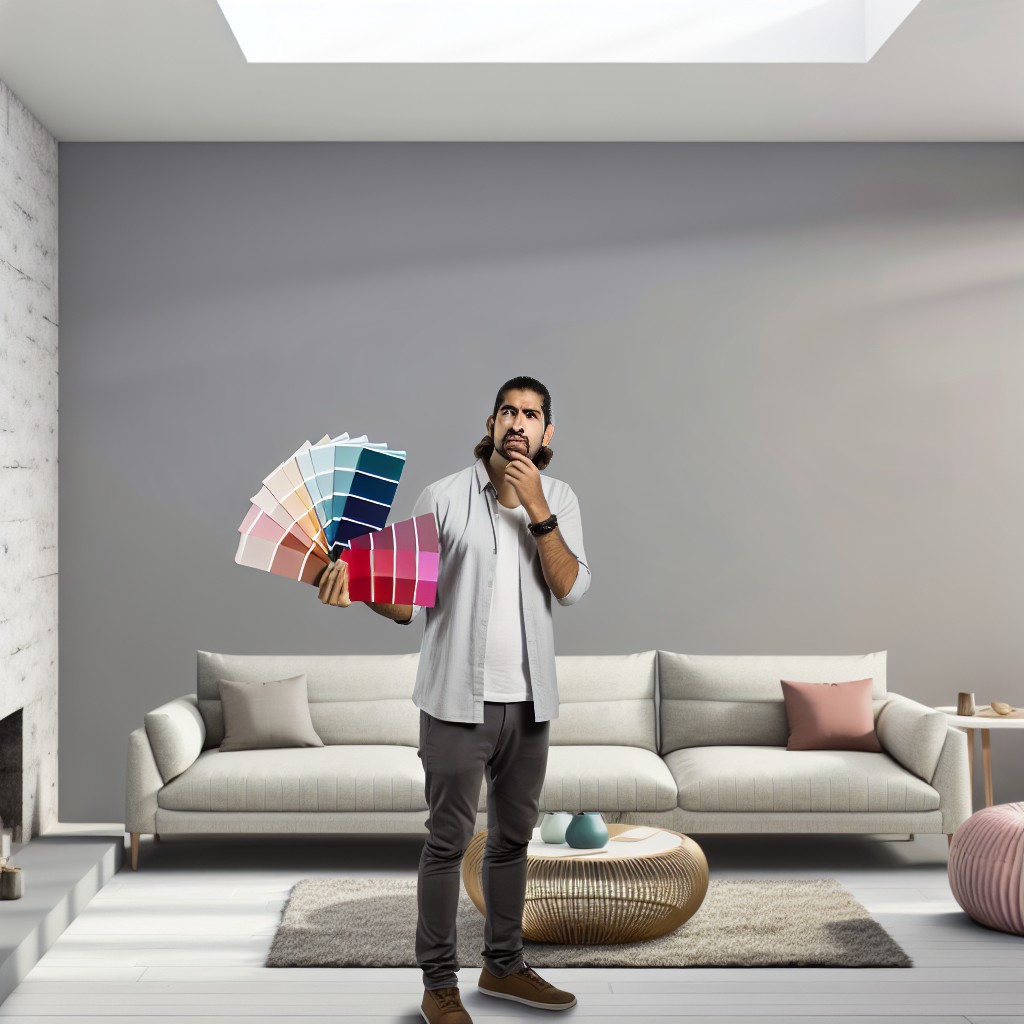Choosing the right paint for your home’s interior is crucial for creating the perfect ambiance.
By selecting the appropriate colors and finishes, you can completely transform and enhance the overall look and feel of a space.
Consider the mood and atmosphere you want to create:
Different paint colors can evoke various emotions in a room.
Examples of popular interior paint colors and their effects:
Warm Colors:
Red: Creates a vibrant and energetic atmosphere.
Orange: Evokes feelings of warmth and comfort.
Yellow: Makes the room feel cheerful and inviting.
Cool Colors:
Blue: Promotes a sense of calm and relaxation.
Green: Symbolizes nature and tranquility.
Purple: Adds a touch of luxury and sophistication.
Neutral Colors:
White: Brightens up space and makes it feel more spacious.
Gray: Provides a modern and elegant look to the room.
Beige: Creates a sense of warmth and neutrality.
Choose the right finish for each room:
Different paint finishes serve different functions in various spaces.
Consider the following finishes based on the room’s purpose:
Matte Finish:
Ideal for living rooms and bedrooms.
Provides a smooth and non-reflective finish.
Covers imperfections well but may be harder to clean.
Satin Finish:
Suitable for kitchens, bathrooms, and kids’ rooms.
Offers a subtle sheen and is easier to clean than matte.
Transform Your Career Today
Unlock a personalized career strategy that drives real results. Get tailored advice and a roadmap designed just for you.
Start NowResistant to moisture and stains, making it durable.
Gloss Finish:
Best for trim, doors, and cabinets.
Has a shiny finish that reflects light beautifully.
Highly durable and can withstand frequent cleaning.
Test the paint colors before committing:
Always test paint colors on a small area before painting the entire room.
Consider how natural and artificial light affects the colors.
Observe how the colors look during different times of the day.
Consider the existing decor and furniture:
Take into account the color scheme of your furniture and decor.
Ensure the paint color complements the existing elements in the room.
Create a cohesive look by choosing colors that enhance the decor.
Seek inspiration from design magazines and websites:
Browse through interior design magazines and websites for ideas.
Look for color palettes and combinations that resonate with you.
Save images of rooms with colors you like for reference.
Consult a professional for expert advice:
If you’re unsure about choosing the right paint color, seek help.
Interior designers and paint experts can provide valuable insights.
Consider hiring a professional for a color consultation to ensure the perfect choice.
Evaluate lighting in the room:
Natural and artificial lighting can impact paint color by altering how colors appear.
Rooms with lots of natural light can make colors appear brighter and more vibrant.
Rooms with low natural light may benefit from warmer paint colors to create a cozy feel.
Choosing the right paint color based on lighting conditions:
- Consider the direction the room faces as it affects how natural light enters the space.
- North-facing rooms receive cooler light, so warmer tones like yellows or reds can offset this.
- South-facing rooms get more sunlight, making cool tones like blues or greens more suitable.
- East-facing rooms have a warm glow in the morning, so cool shades work well to balance it.
- West-facing rooms have a warm glow in the evening, so cooler tones can help neutralize it.
- Artificial lighting, like overhead lamps and bulbs, can also impact how colors appear.
- Consider the type of lighting used (warm or cool) and its intensity when choosing paint.
- When in doubt, test paint colors on small sections of the wall to see how they look in different lighting.
- Remember that lighting changes throughout the day, so observe colors at different times.
You Might Also Like: Top Schools for Power Line Installer Training
Transform Your Career Today
Unlock a personalized career strategy that drives real results. Get tailored advice and a roadmap designed just for you.
Start NowChoosing Paint Colors for Your Home
It’s important to consider the size and layout of the room when choosing paint colors for your home’s interior.
How Paint Color Affects Perception of Space
The color of the paint can have a significant impact on how large or small a room feels.
Light colors tend to make a room feel more spacious, while dark colors can make a room feel cozy but also smaller.
Recommendations for Small Rooms
For small rooms, it’s generally best to stick with light, neutral colors.
Light shades such as white, cream, or pale gray can help open up a small space and make it feel more airy and inviting.
Avoid dark colors that can make the room feel cramped.
Recommendations for Large Rooms
In larger rooms, you have more flexibility with paint colors.
While you can still use light colors to create a sense of openness, you can also experiment with darker hues to add warmth and depth to the space.
Bold colors like deep blue or rich green can create a striking focal point in a large room.
Consider the Layout of the Room
In addition to the size of the room, consider its layout when choosing paint colors.
Cool colors like blue and green can help visually expand a narrow room, while warm colors like red and orange can make a long room feel more balanced.
Harmonizing with Existing Decor
When selecting paint colors, also take into account the existing decor in the room.
Choose colors that complement the furniture, flooring, and other elements to create a cohesive and harmonious space.
Consider how the color will interact with the natural light in the room throughout the day.
Test Paint Samples
Before committing to a color, it’s essential to test out paint samples on the walls.
Paint a small section and observe how the color looks in different lighting conditions.
This will help you ensure that the paint color you choose works well with the room’s size, layout, and decor.
Finding the Perfect Color for Your Space
Choosing the right paint color for your home’s interior involves careful consideration of the room’s size, layout, existing decor, and desired atmosphere.
By following these recommendations and testing paint samples, you can find the perfect color to enhance your living space.
Explore Further: Lumberjack Safety Gear: Essential Equipment for the Job
Transform Your Career Today
Unlock a personalized career strategy that drives real results. Get tailored advice and a roadmap designed just for you.
Start NowResearch different types of paint finishes:
- Explain the differences between matte, eggshell, satin, semi-gloss, and high-gloss finishes.
- Suggest which finish might be best for different areas of the home.
When it comes to choosing the right paint for your home’s interior, one of the key considerations is the type of finish you want to achieve.
Different paint finishes offer varying levels of sheen, durability, and ease of maintenance.
Matte Finish:
Matte finishes are ideal for creating a smooth, subtle look with little to no shine.
They are great for concealing imperfections on walls and ceilings, making them a popular choice for bedrooms, living rooms, and dining areas.
However, matte finishes can be more challenging to clean and may not withstand heavy scrubbing.
Eggshell Finish:
Eggshell finishes have a slight sheen that adds a touch of elegance to walls while still being easy to clean.
They strike a balance between matte and satin finishes, making them suitable for high-traffic areas like hallways, entryways, and kids’ rooms.
Satin Finish:
Satin finishes have a soft sheen that offers a subtle glow to walls.
They are durable and easy to clean, making them a versatile choice for kitchens, bathrooms, and laundry rooms where moisture and stains may be concerns.
Satin finishes are also great for trim and doors for a bit of contrast.
Semi-Gloss Finish:
Semi-gloss finishes have a noticeable shine that reflects light, making them highly durable and resistant to moisture.
They are perfect for areas prone to splashes and spills, such as kitchens, bathrooms, and trim work.
However, semi-gloss finishes can accentuate surface imperfections.
High-Gloss Finish:
High-gloss finishes have a mirror-like sheen that is ultra-shiny and easy to clean.
They are the most durable and stain-resistant, making them ideal for high-traffic areas like baseboards, doors, and cabinets.
High-gloss finishes are also well-suited for accent walls and furniture.
Choosing the Right Finish for Different Areas:
- Matte finish: Bedrooms, living rooms, dining areas.
- Eggshell finish: Hallways, entryways, kids’ rooms.
- Satin finish: Kitchens, bathrooms, laundry rooms, trim.
- Semi-gloss finish: Kitchens, bathrooms, trim work.
- High-gloss finish: Baseboards, doors, cabinets, accent walls, furniture.
Ultimately, the right paint finish for your home’s interior will depend on your personal style, the function of each room, and your maintenance preferences.
Consider these factors when selecting the perfect paint finish to achieve the desired look and feel throughout your home.
Find Out More: Understanding Sheet Metal Worker Union Benefits
When choosing the right paint for your home’s interior, it’s important to consider the durability and ease of maintenance.
Transform Your Career Today
Unlock a personalized career strategy that drives real results. Get tailored advice and a roadmap designed just for you.
Start NowHere are some key points to keep in mind:
Durability of Paint Brands and Types
- Look for reputable brands known for their quality and durability.
- Check consumer reviews to see how different paint types hold up over time.
- Consider the traffic in the room when choosing a paint that can withstand wear and tear.
- Opt for paint with a higher sheen for areas prone to moisture and humidity like bathrooms and kitchens.
- Keep in mind that darker colors tend to show wear and tear more easily than lighter shades.
Ease of Maintenance
- Choose a paint finish that is easy to clean, especially in high-traffic areas.
- Flat and matte finishes can be harder to clean, while satin and semi-gloss are more washable.
- Consider using washable and scrubbable paint for areas that are prone to staining.
- Look for paint that is resistant to mold and mildew, especially in damp areas of the home.
- Opt for paints with low VOC (volatile organic compounds) for easier cleanup and less harmful fumes.
By considering the durability and ease of maintenance when choosing paint for your home’s interior, you can ensure that your walls look great for years to come with minimal effort.
Gain More Insights: Understanding Tile Layout Patterns for Stunning Designs

Test Paint Samples Before Committing
Before diving into painting your entire home, it is essential to test paint samples first.
Here are some tips on how to go about this process:
Try Out Small Samples:
- Choose a few different paint colors that you are considering for your walls.
- Get small sample cans of each color from your local paint store.
- Paint a small section of your wall with each sample color to see how it looks.
Evaluate in Different Lighting Conditions:
- Look at the paint samples during different times of the day to see how they appear in natural light.
- Consider how the colors look in both daylight and artificial lighting.
- Make sure to test samples in various rooms with different lighting situations.
By testing paint samples before making a final decision, you can avoid costly mistakes and ensure that you choose the right paint for your home’s interior.
Seek professional advice if needed:
- Recommend consulting with a professional painter or interior designer for expert guidance.
- Provide tips on how to find a reliable painting professional in your area.
When it comes to choosing the right paint for your home’s interior, seeking professional advice can be incredibly helpful.
Professional painters and interior designers have the expertise and experience needed to guide you in making the best decisions for your space.
Why Consult a Professional?
Consulting with a professional can help you avoid costly mistakes and ensure that you achieve the desired results.
They can provide valuable insights on color selection, finishes, and techniques that will enhance the overall look and feel of your home.
Tips for Finding a Reliable Painting Professional:
- Ask for Recommendations: Reach out to friends, family, and neighbors for referrals to trustworthy painters or interior designers they have worked with in the past.
- Research Online: Utilize online resources such as websites, forums, and social media to find reputable professionals in your area with positive reviews and portfolios of their work.
- Check Credentials: Make sure to verify the credentials and qualifications of the professionals you are considering, such as licenses, certifications, and insurance coverage.
- Request Estimates: Obtain multiple quotes from different professionals to compare prices and services offered, ensuring that you are getting value for your investment.
- Interview Potential Candidates: Schedule consultations with the professionals to discuss your project, vision, and expectations to see if they are a good fit for your needs.
- Review Contracts Carefully: Before hiring a painting professional, carefully review the contract terms, including scope of work, timeline, payment schedule, and warranties to avoid any misunderstandings or disputes.
By following these tips and seeking guidance from a professional, you can make informed decisions when choosing the right paint for your home’s interior.
Remember, investing in professional assistance can ultimately save you time, money, and frustration in the long run.
Choosing the Right Interior Paint
After considering various factors such as color psychology, lighting, and personal preferences, it is crucial to choose the right paint for your home’s interior.
Recapping the key points discussed in this blog post, it is important to select a color that matches the overall aesthetic of your home and enhances the ambiance.
Additionally, it is essential to test samples on your walls and observe how the color changes throughout the day to ensure you are happy with the final result.
Encouraging readers to take their time in choosing the right paint for their home’s interior will help them achieve the desired look and feel they envision for their space.
Remember, the right paint color can transform a room and create a welcoming atmosphere that reflects your style and personality.
So, make an informed decision, experiment with different shades, and don’t rush the process to create a home you truly love.
Additional Resources
What term can be used for a plumber, electrician, carpenter, welder …
Transform Your Career Today
Unlock a personalized career strategy that drives real results. Get tailored advice and a roadmap designed just for you.
Start Now



